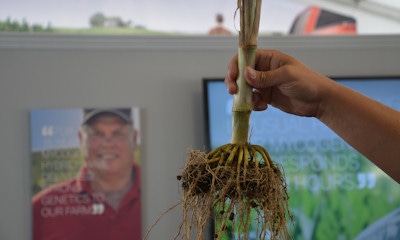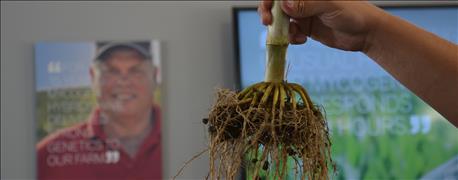
Melissa Bell is happy when she is in the field following the progress of various trials she sets up. She’s not interested in hybrid trials as much as trials that compare plant seeding rates amongst various hybrids. She also likes to work with farmers. Bell, commercial sales agronomist for Mycogen Seeds, set up tests over the past two years to see how seeding rates affected plant traits and yield.

GOOD ROOTS: With some hybrids lower seeding rates may produce root systems that penetrate deeper. However, Melissa Bell also carries her comparisons to yield to see which seeding rates yield best for each hybrid.
Bell lives in west-central Indiana but does most of her work in east-central Illinois. Last year’s plots were hampered by excessive rains, causing yield issues, especially in what are usually the better soils. Last year the soils with highest organic matter were lower yielding, she notes. It was the reverse of what she saw in 2014.
Here is a short interview with Bell.
IPF: What happens to plant roots as seeding rates change?
Bell: At 31,000 plants per acre roots tended to penetrate deeper into the soil. This was especially true compared to looking at roots of the same hybrid at 40,000. The roots really begin to change as you go to seeding rates which are that high.
What did you see at the 40,000 seeding rate?
Bell: We saw more stalk lodging and smaller ears, especially last year. We really saw these effects the most in wet spoils.
What have you concluded after two years of comparing various seeding rates, digging roots and looking at ears and yield?
Bell: Getting the best performance is all about matching hybrids to soil type, and then matching populations of that hybrid to soil type as well. That is the take-home message that I have uncovered so far.
So is there a place for variable-rate planting in corn?
Bell: Variable-rate planting definitely has a fit. It is going to be more important for some farmers than others. Those with soils that vary more will likely see the biggest benefit.
So is it a matter of paying attention to all three factors: hybrid selection, seeding rate and soil type?
Bell: Absolutely! You need to know the characteristics of the hybrid, and know how it will respond on various soils at various seeding rates. The key is matching up these factors for the best result.
About the Author(s)
You May Also Like




